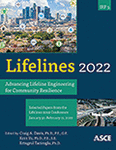Field Monitoring of the Persistence of Microbially Induced Desaturation for Mitigation of Earthquake Induced Soil Liquefaction in Silty Soil
Publication: Lifelines 2022
ABSTRACT
Earthquake liquefaction hazards in silty soils are a critical problem in Portland, Oregon, and other areas around the world. Recent studies suggest that liquefaction mitigation using microbially induced desaturation (MID) may provide the capability to mitigate liquefaction potential beneath existing structures in a cost-effective manner. The objective of MID is to reduce earthquake-induced excess pore water pressure generation compared to saturated soil, and thereby reduce the potential for triggering liquefaction. A field study of liquefaction mitigation using MID was performed at two sites in Portland in the summer of 2019. Low-plasticity, liquefiable silts were treated with MID by injecting a treatment solution to stimulate native bacteria for a duration of four weeks. This paper presents monitoring data that evaluate the level of desaturation before, during and after the completion of the MID trials. Monitoring included crosshole pressure-wave velocity measurements, a vertical array of embedded sensors that measure water content and bulk electrical conductivity, pre- and post-treatment seismic cone penetration tests, and direct soil sampling of the treated soils. Monitoring at both sites indicated that liquefiable silts were successfully desaturated. The persistence of desaturation was monitored for 8 months post-treatment at one site and is ongoing at the other site. The monitoring data indicate that the induced desaturation has persisted through seasonal fluctuations of the ground water table since the end of treatment. These data, which document MID longevity, are particularly important to establish MID as a viable option for liquefaction mitigation of silty soils that threatens lifelines worldwide.
Get full access to this article
View all available purchase options and get full access to this chapter.
REFERENCES
Bauer, J. M., Burns, W. J., and Madin, I. P. (2012). “, Earthquake regional impact analysis for Clackamas, Multnomah, and Washington counties, Oregon.”
Boulanger, R. W., and Idriss, I. M. (2006). “Liquefaction susceptibility criteria for silts and clays.” Journal of Geotechnical and Geoenvironmental Engineering, ASCE, 132(11), 1413–1426.
Bray, J. D., and Sancio, R. B. (2006). “Assessment of the liquefaction susceptibility of fine-grained soils.” Journal of geotechnical and geoenvironmental engineering, ASCE, 132(9), 1165–1177.
Gallant, A. P., and Finno, R. J. (2017). “Measurement of gas released during blast densification.” Geotechnical Testing Journal, 40(6), 1011–1025.
Hall, C. A., van Paassen, L., Kamalzare, S., Parmantier, D., and Kavazanjian, E., Jr. “Techno-Economic Assessment of Liquefaction Mitigation by Microbially Induced Desaturation.” Submitted to ASCE Lifelines Conference 2021 (under review).
He, J., Chu, J., and Ivanov, V. (2013). “Mitigation of liquefaction of saturated sand using biogas.” Géotechnique, 63(4), 267–275.
Hull, D. A. (1991). “Geologic Map of the Portland Quadrangle, Multnomah and Washington Counties, Oregon, and Clark County, Washington.”, Department of Geology and Mineral Industries.
O’Donnell, S. T., Kavazanjian, E., and Rittmann, B. E. (2017). “MIDP: Liquefaction Mitigation via Microbial Denitrification as a Two-Stage Process. II: MICP.” Journal of Geotechnicaland Geoenvironmental Engineering, 143(12), 04017095.
O’Donnell, S. T., Rittmann, B. E., and Kavazanjian, E. (2017). “MIDP: Liquefaction Mitigation via Microbial Denitrification as a Two-Stage Process. I: Desaturation.” Journal of Geotechnical and Geoenvironmental Engineering, 143(12), 04017094.
Okamura, M., and Teraoka, T. (2006). “Shaking table tests to investigate soil desaturation as a liquefaction countermeasure.” Geotechnical Special Publication, ASCE, 145, 282–293.
Pham, V. P., van Paassen, L. A., and van der Star, W. R. L. (2018). Quantifying the desaturation effect of biogenic gas formation in sandy soil. In Proceedings of the 7th International Conference on Unsaturated Soils.
Pham, V. P., van Paassen, L. A., van der Star, W. R., and Heimovaara, T. J. (2018). Evaluating strategies to improve process efficiency of denitrification-based MICP. Journal of Geotechnical and Geoenvironmental Engineering, 144(8), 04018049.
Preciado, A. M., Sorenson, K., Khosravifar, A., Moug, D., Stokoe, K., Menq, F., and Zhang, B. “Evaluating Cyclic Loading Response of a Low Plasticity Silt with Laboratory and In-Situ Cyclic Loading Tests.” Submitted to ASCE Lifelines Conference 2021 (under review).
Stallings Young, E. G., Zapata, C. E., and van Paassen, L. (2020). “Unsaturated Fluid Flow through Granular Soils Treated with Microbial Induced Desaturation and Precipitation.”
Valle-Molina, C., and Stokoe, K. H. (2012). “Seismic measurements in sand specimens with varying degrees of saturation using piezoelectric transducers.” Canadian Geotechnical Journal, 49(6), 671–685.
Vega-Posada, C. A., Finno, R. J., and Zapata-Medina, D. G. (2014). “Effect of Gas on the Mechanical Behavior of Medium-Dense Sands.” Journal of Geotechnical and Geoenvironmental Engineering, 140(11), 04014063.
Wang, L., van Paassen, L., Gao, Y., He, J., Gao, Y., and Kim, D. (2020). Laboratory Tests on Mitigation of Soil Liquefaction Using Microbial Induced Desaturation and Precipitation. Geotechnical Testing Journal, 44(2).
Wang, Y., Bartlett, S. F., and Miles, S. B. (2012). Earthquake Risk Study for Oregon’s Critical Energy Infrastructure Hub, State of Oregon, Salem, OR.
Yegian, M. K., Eseller-Bayat, E., Alshawabkeh, A., and Ali, S. (2007). “Induced-Partial Saturation for Liquefaction Mitigation: Experimental Investigation.” Journal of Geotechnical and Geoenvironmental Engineering, 133(4), 372–380.
Information & Authors
Information
Published In
History
Published online: Nov 16, 2022
Authors
Metrics & Citations
Metrics
Citations
Download citation
If you have the appropriate software installed, you can download article citation data to the citation manager of your choice. Simply select your manager software from the list below and click Download.
